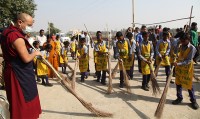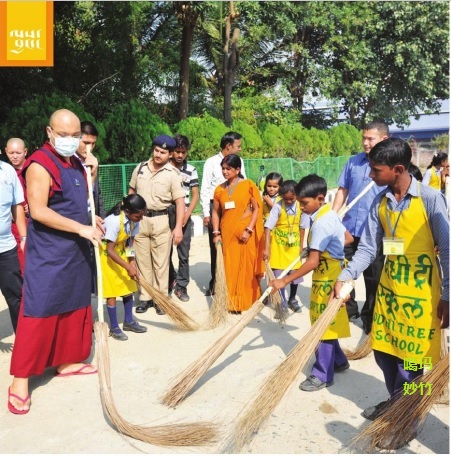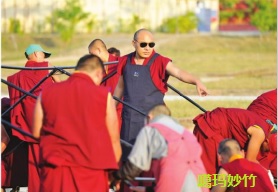法王新闻 | 2014年11月
『菩提迦耶』率眾清掃街道與搭建帳棚
『Bodhgaya』Leading the Way: Street Cleaning and Pitching Tents
༄༅།། རྒྱ་གར་ཁོར་ཡུ་་གཙང་ཕྱགས་ཉིན་མོ།

時間:2014年11月12日 12 Nov., 2014
地點:印度 菩提迦耶 Bodhgaya, India
The Gyalwang Karmapa has often quipped that the word ‘Karmapa’ is somewhat equivalent in meaning to “Action Man”. He is now recognised as a leader who ‘does’ as well as ‘says’, and repeatedly urges his followers to transform their Buddhist beliefs into action.
法王經常笑言,「噶瑪巴」的意思有點像是「機動人」。法王目前已被公認為是「言說」與「行動」俱佳的領袖,他經常不厭其煩地敦促信眾,應該將自己的佛教信仰化為實際的行動:
“Because our lives are interdependent, we carry the responsibility for ourselves, for the welfare of our family and friends, and for all living beings in the world. Interdependence is not just a philosophy: it’s a way of life,” he has said.
「我們的生命相互依存,所以我們對自己有責任,對我們的家人和朋友有責任,也對世界上所有的生靈有責任。相互依存不只是哲理,它是一種生活的方式。」

This morning, reflecting his advice that we should all take individual responsibility for protecting the environment, he met with an enthusiastic group of children from the local Bodhi Tree School and joined them in cleaning the local area.
今晨法王以身作則,與一群來自當地菩提樹學校的學童一起清掃街道,實踐他所強調的:環境保護,人人有責。
The school is currently leading a campaign in conjunction with students from Magadh University to clean up the environment. The Karmapa has a long-standing connection with the Bodhi Tree Educational Foundation, a non-profit organisation which supports and helps develop educational programmes for children and their families in Bodhgaya and Bihar. The organisation provides schools and vocational training, healthcare and courses in safer childbirth and neo-natal care, as well as nutritional and medical support for children.
菩提樹學校目前正與摩揭大學攜手推行環境清潔運動。法王與菩提樹教育基金會的關係歷史悠久;該基金會為非營利組織,旨在支援和協助菩提迦耶與比哈爾省的學童及其家庭,為他們設計教育課程,提供學校和職業訓練、健康保健、更安全的分娩和新生兒照料,以及兒童的營養和醫療照護。
Before they began this morning’s street cleaning activity, the Karmapa was asked to address the students. Explaining that Tibetans have great reverence for India, particularly for Bodhgaya, the place where the Lord Buddha attained enlightenment, he explained that they call India the Arya Bhumi or Noble Land.
上午掃街的活動開始前,法王應邀對學生們進行開示。法王說明,藏人稱印度為「聖域」,對印度極為崇敬,而對於佛陀成道的菩提迦耶更是如此。
Those who live in Bodhgaya, he suggested, have both the privilege of sharing in the nobleness of the place, and a responsibility to use that nobleness of mind to set an example which will inspire the people who come there, most of whom are pilgrims or have some spiritual purpose. He concluded by saying how much he supported and rejoiced to see the students’ efforts to protect and clean the environment, as an ideal way of both bringing benefit to those who come here and also of setting an example.
法王指出,菩提迦耶的居民在同霑聖地之崇偉的同時,也有善用此崇偉之心的責任,應該為以朝聖者居多的訪客,樹立啟發人心的典範。結語中,法王對於學生們為環境的保育和整潔所付出的努力,表示極度支持和歡喜。
His Holiness then took up a traditional broom made from thin sticks and joined the children in sweeping the dusty street and collecting litter and rubbish.
接著,法王拿起一支以草桿製成的傳統掃帚,加入學童們的行列,一起清掃塵埃滿地的街道,撿拾垃圾和廢物。

In the afternoon, His Holiness left his quarters and strode down the road to the fields beside the nearby Monlam Pavilion to inaugurate the pitching of the tents for this year’s garchen – an encampment which continues the tradition established by earlier Karmapas in Tibet. Within a few days, hundreds of shedra monks will begin arriving for the annual Kagyu Gunchö or Winter Debate Session and these tents will be their home for the next two months.
下午,法王前往祈願會場旁邊的空地,為今年「嘎千大營地」的帳棚搭建拉開序幕;「嘎千大營地」為第四世法王噶瑪巴在西藏創建的傳統,近年來由第十七世法王在菩提迦耶復興。幾天後,將有數百位佛學院的學僧抵達菩提迦耶,參加每年一度的噶舉冬季辯經法會,而「嘎千大營地」便是他們未來兩個月的住處。
Later, more tents will be erected in a separate area for the nuns who will join the monks for the Kagyu Monlam Prayer Festival and stay on for their own winter debate session in January 2015.
之後,在另外一區將會搭建起更多的帳棚,以供前來參加噶舉大祈願法會的尼眾居住。而祈願法會結束後,部分尼眾將繼續居住在「嘎千大營地」,以便參加於2015年一月份舉行的第二屆「讖摩比丘尼辯經法會」。

In a routine familiar from previous years, the Karmapa took charge of the proceedings and personally demonstrated to the group of fifteen or so monks and helpers what to do and how to do it. Working together they deftly assembled the metal frame for the first tent and placed it on the already-prepared foundation. The Karmapa then co-ordinated the correct positioning of the canvas over the frame and, with the advantage of his height, helped manoeuvre it into place, prompting the monks: “One,two,three, pull!”
遵循著前幾年的流程,法王帶領約15位的僧眾和助手,親自指揮並示範帳棚的搭建。同心協力下,眾人輕巧地搭建起第一座帳棚的金屬框架,並將它放置在事先整頓好的營地上。接著,法王指揮眾人將帳棚的帆布放到金屬架上,然後運用自己身高上的優勢,將帆布安置到正確的位置,接著發號施令:「一、二、三,拉!」

After six tents had been pitched, it was time for a short rest and a tea break, with cake and tea served at the work site. Then it was back to work until, as the light began to fade, the Karmapa called it a day, and returned to Tergar Monastery.
在圓滿了6座帳棚的搭建後,眾人就地在營區享用一些茶水和糕點。短暫休息後,法王率眾繼續工作,直至日落西山。
网页修改记录:2024年07月10日,新建网页。
